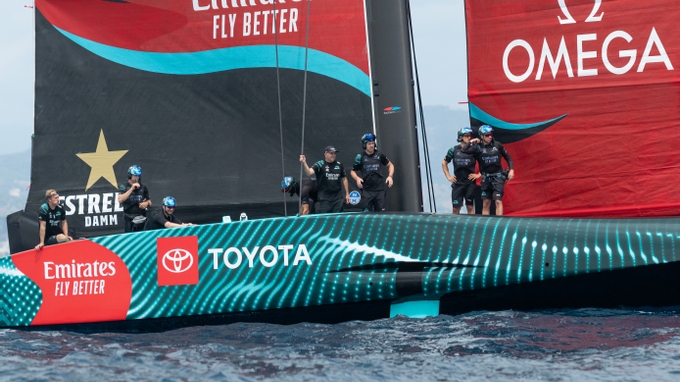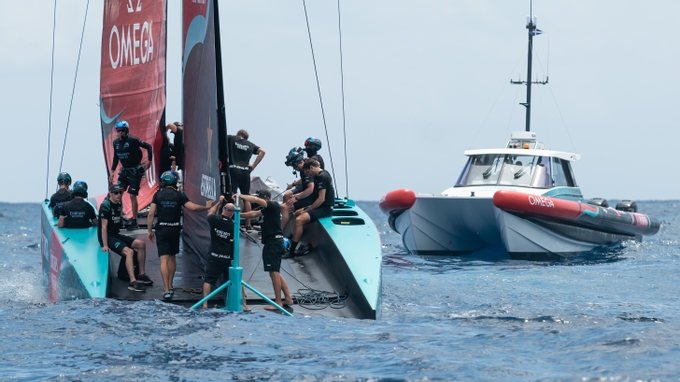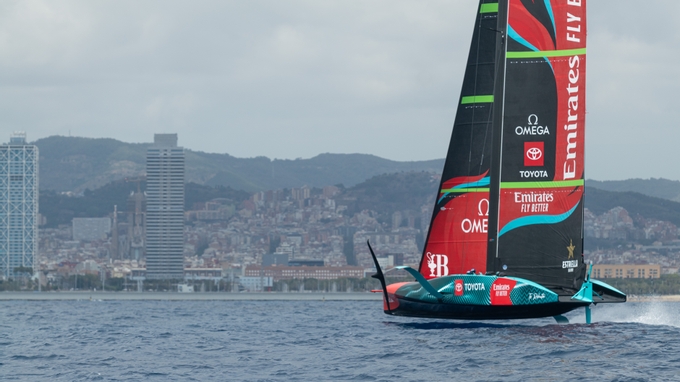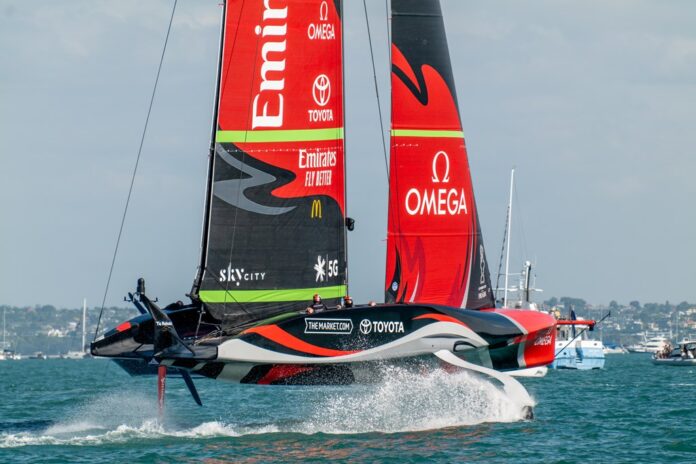Emirates Team New Zealand came ashore after a long session that took them all around the Barcelona waterway with a lot of lessons learned and a real premium on trim, moding, accuracy of steering and flight control.
It was tough out there at times, especially early afternoon when the conditions got marginal for foiling or to be more specific, manoeuvring, with Andy Maloney and Blair Tuke trimming the forestay tension and jib like they were back in high-performance dinghies. Going through the waves, particularly from starboard to port, the trimmers were working hard to deliver the power whilst Nathan Outteridge and Pete Burling were sailing wide angles, scalloping to leeward for power before coming back on course as the foils ‘bit’ with the flow attachment. It was an endless task until the team went to greet the incoming southerly/south-easterly that was building offshore and trailed it all the way back into the Barceloneta racecourse area where they had ‘Te Rehutai’, the Cup winning AC75, on rails as they rifled through a series of pre-starts and laps.
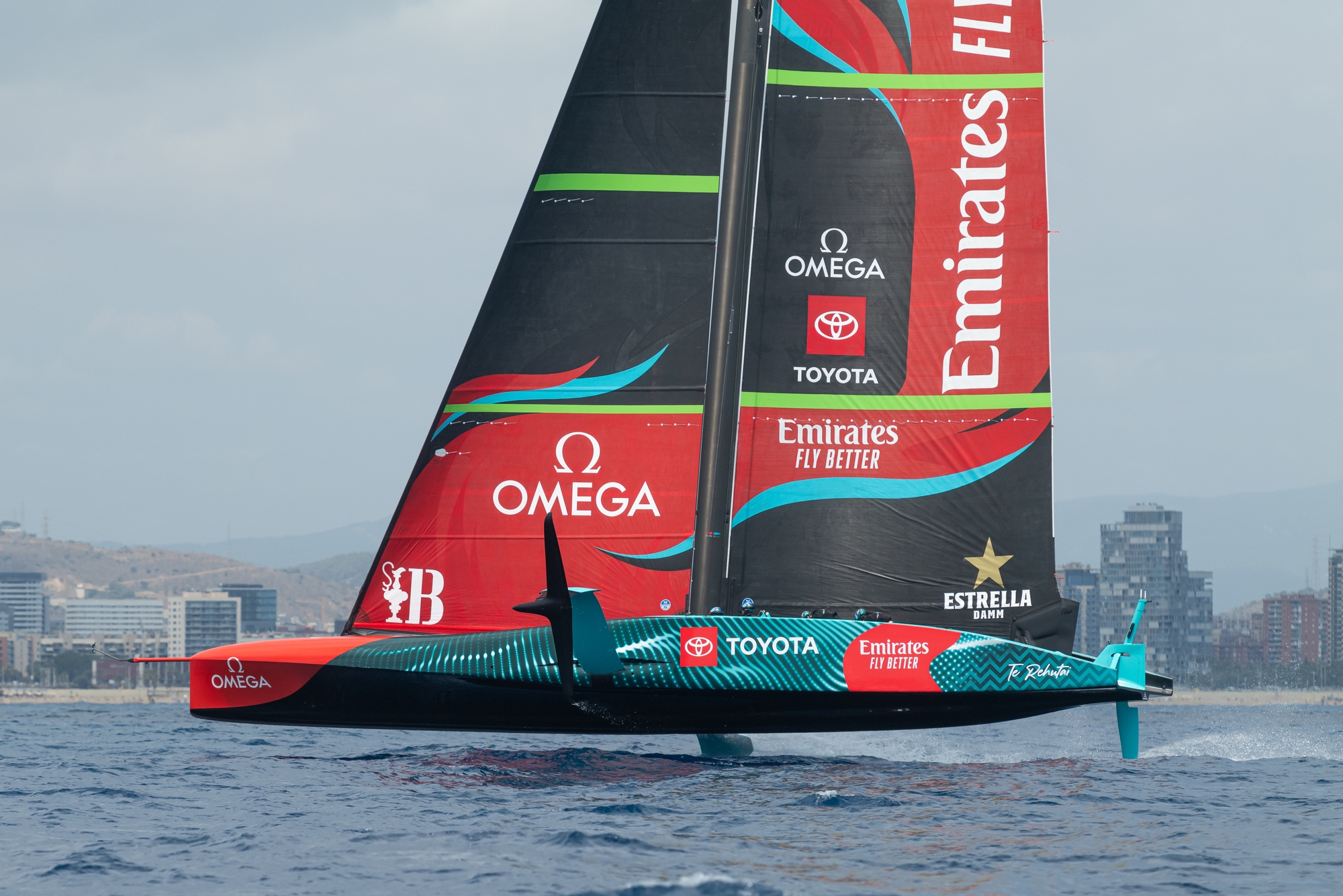
Gybing downwind on the inshore racecourse area was something of a concern, perhaps with slightly too much respect being given to the lighter conditions with the resultant stern-first splashdowns being the effect of over-steering. This is a fast-learning team and they’ll be looking at those exits and poring over the data to improve. One feature that we see time and again with Emirates Team New Zealand is that Blair and Andy will dial the hull desperately close to the water both upwind and downwind almost regardless of the conditions. Watch this trend, it could be the DNA of AC75s being unlocked and will be much-copied around the America’s Cup village.
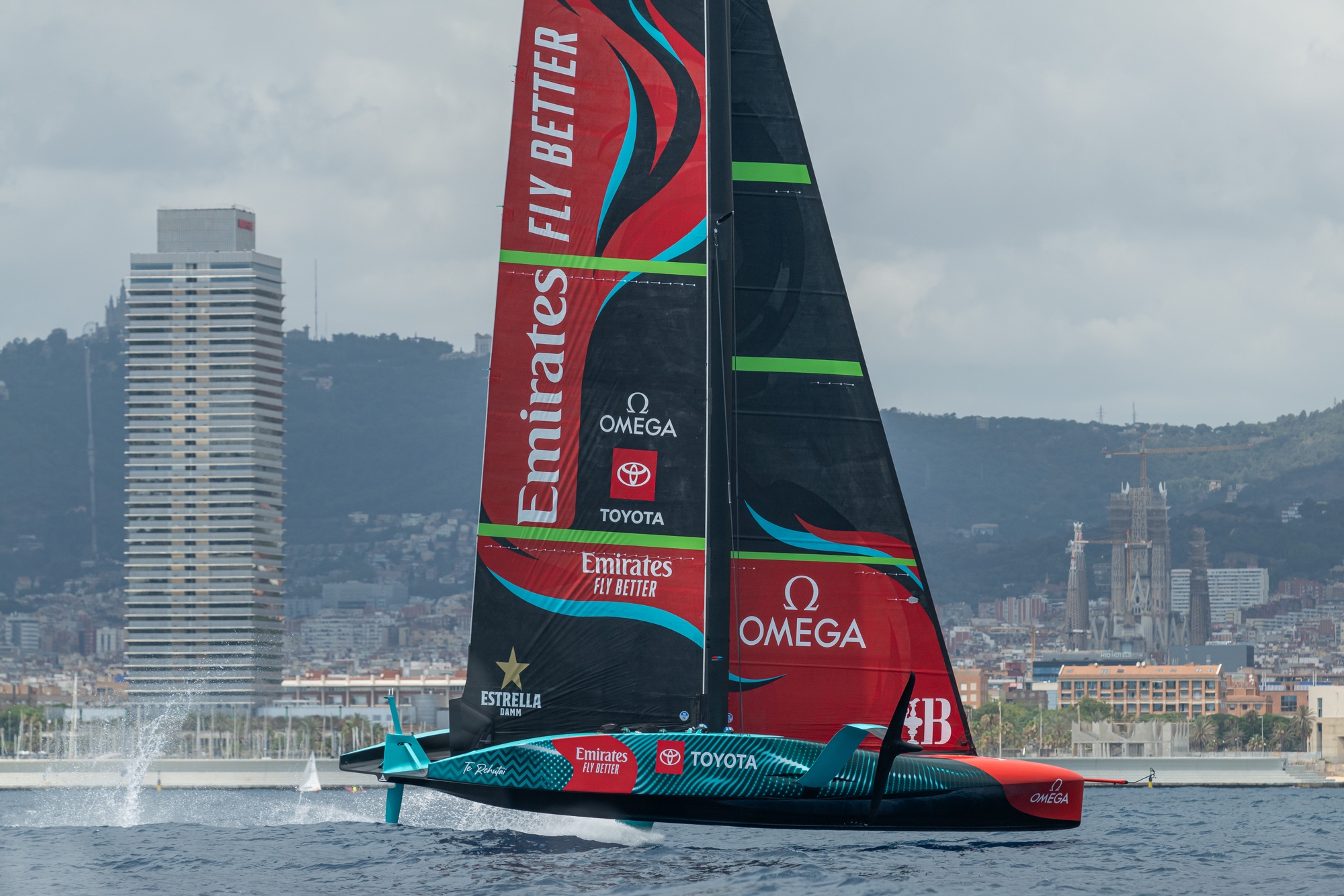
Andy Maloney, an alumnus of the talent-factory that is the famous Murrays Bay Sailing Club in New Zealand, gave his run down of the day saying: “Another awesome day of learning here in Barcelona. We had the breeze from sort of South-South-East and a big sea state from a bit more to the east so breeze around sort of 7 to 11 knots of wind and just a really good day for learning for us…Early on there was a bit more breeze offshore so we ended up heading offshore a little bit and then by the end of the day it filled nicely down on the racecourse area, so we got to do a few laps at the end.”

Andy, understandably, wouldn’t be drawn on the techniques that the team have been using so effectively in the lighter airs but did allude to the wave technique saying: “Just super dynamic out there with the waves, so just trimming around it.” Andy and Blair’s ability through those dynamic situations in the light is where the team have been really concentrating their efforts to create tangible gear-shifting momentum in high co-ordination with the helmsmen – fascinating to watch. Another good day on the water for Emirates Team New Zealand who are functioning well as a unit here in Barcelona all round from top to bottom.
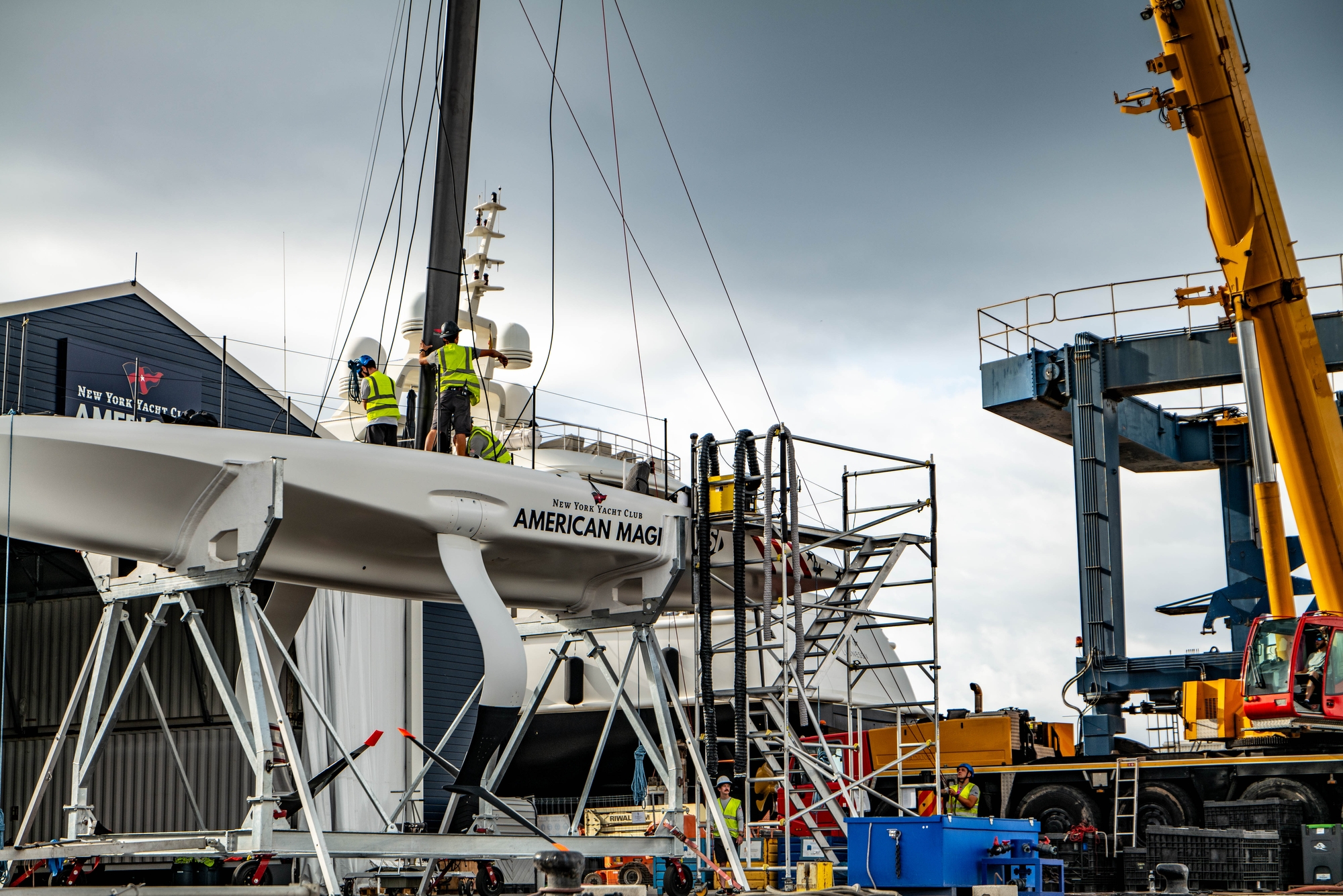
Another team that are almost impossible to take your eyes off in Barcelona now is NYYC American Magic who brought Tom Slingsby into the two-boat training, sailing with alternate helm Lucas Calabrese on the moded ‘America’ with Andrew ‘Rookie’ Campbell and Riley Gibbs on trim. Meanwhile on ‘Magic’, the next generation sailing continued with the highly impressive duo of Severin Gramm (trim) and Harry Melges (helm) learning from Paul Goodison and Michael Menninger. The Americans are taking the Youth America’s Cup seriously and they’ve found gold-dust with their trio of sailors (Finn Rowe being the other) who have settled in super-well to the team and are acquitting themselves magnificently both off and on the water.
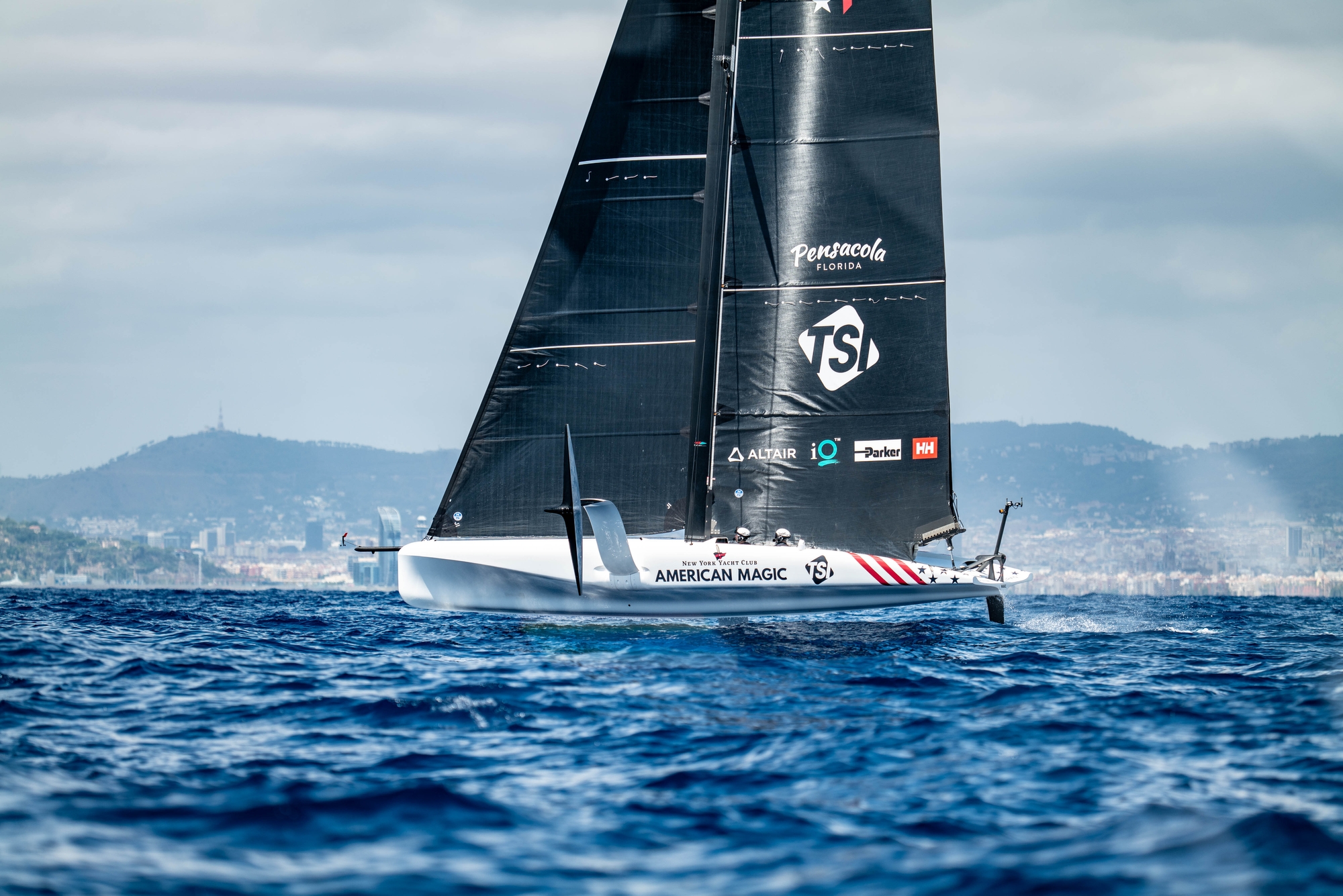
American Magic had the obligatory drones flying low in the sky today, trained relentlessly on the starboard wings of both boats when they managed to get flying and took back ashore a total of 1 hour and 42 minutes of flight data over a three-and-a-half-hour session. However, the one big talking point was a long starboard tack where both boats were flying on their one-design port foils and within 15 minutes, having started to leeward, ‘America’ was significantly ahead. This perhaps points to better systems controls on the much modified ‘America’ although the Slingsby/Calabrese axis might have a different take – whatever, it was impressive boat speed eked out over a relatively longer straight-line distance.
Talking about the two-boat session with Severin Gramm, we got youthful enthusiasm as well as a refreshing insight as he described the programme that he and the other American Magic Youth sailors are on: “Yep training for the upcoming Youth America’s Cup and also helping out on shore however I can, just learning as much as I possibly can every single day, the learning curve has been vertical, it’s been awesome and yeah can’t wait to keep learning.”
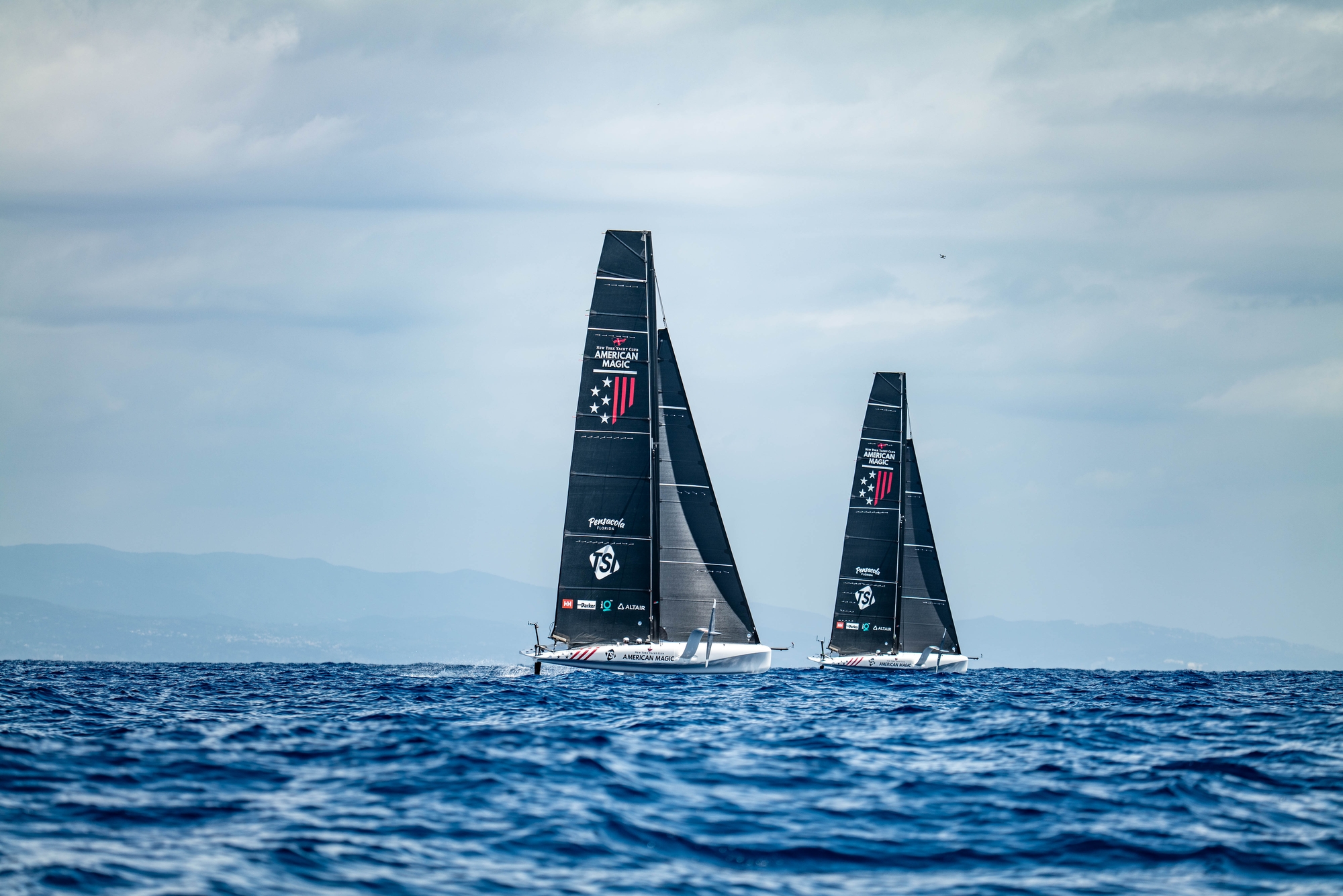
And describing the day, Severin dived into the reality of sailing in choppy conditions and lighter winds saying: “It was probably the waviest day that we’ve had, and in combination with lighter breeze it definitely provided a challenge both up and downwind…The hardest part is probably the take-offs, managing the heel with the waves coming across your beam, they’ll kind of roll you either a lot to leeward or a lot to windward so trying to have a consistent feel for take-off is the most challenging.”
In the early part of the session, the team’s AC40s were often in displacement mode waiting for the southerly to come through but for Severin on trim he gave a perfect dinghy sailor’s answer: “Yeah, that just added to the challenge but once you’re up and foiling typically you lock in with the groove and it was more manageable…we experimented with a lot of different settings but eventually we landed on a combination that felt more stable for us but it was definitely more of a head out of the boat kind of day than most.”
NYYC American Magic are very much a team to keep your eye on in this competition. Many people’s pick to go deep, there’s talent to burn in this exciting sailing squad with an equal smattering of todays and tomorrow’s sailing superstars. A brilliant America’s Cup programme that’s really executing now.
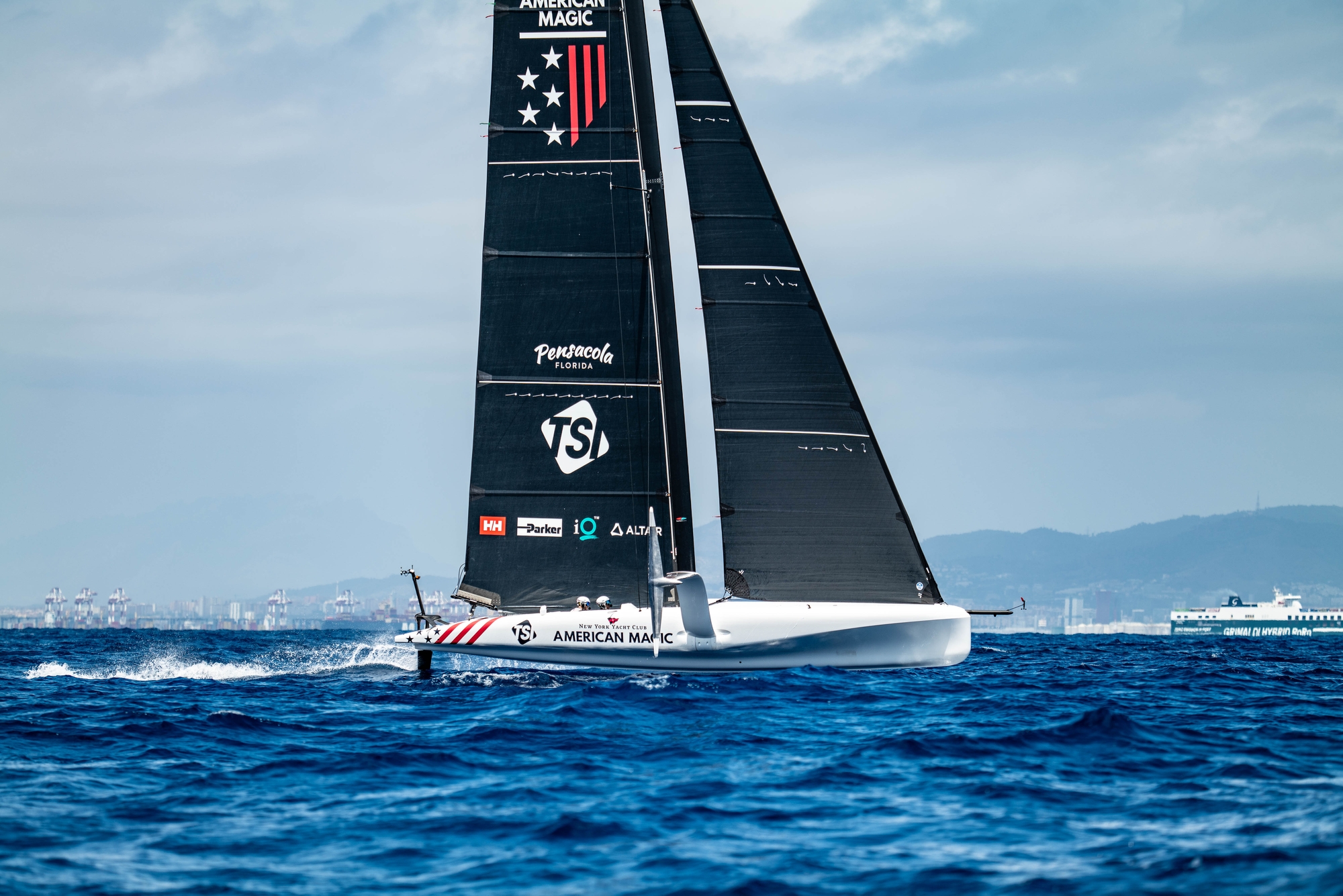
On Water Recon Unit Notes – Emirates Team New Zealand: ETNZ rolled out their B2 AC75 from the shed at 10.30 am. The boat was craned to the water at 11:07 and the team docked out at 12.00. The M1 and the J3 were hoisted at 12:13, inside the harbour.
Today´s training consisted of “a bit of everything”. Some straight-line training at the beginning, then a couple manoeuvres and a few pre-start simulations at the end of the day without using marks. During the first part of the day, ETNZ sailed with their J3 for 53 minutes. They did three stops in which they performed different adjustments under the deck. The front and back deck hatches were removed, and different people went inside, under the deck, including team members coming from the chase boats.
After that first hour, they changed the J3 for the J2, which looked much more appropriate for the wind intensity conditions they had from the beginning of the day up to that moment.
The same routine continued with the J2 up, that stayed for another half an hour. Some further adjustments were done on the lower back part of the mainsail, in between the two skins, using tools. Later on, as the wind increased the J3 was re-hoisted in replacement of the J2, and some manoeuvres were performed.
As regards manoeuvres, ETNZ did approximately 22 tacks and 18 gybes, with some ups and downs. Landing completely at least on two gybes and tacks, touching and going on six and five, respectively; and flying on the rest. When talking about boat tuning, an important amount of sag could be noticed on the forestay, being very active, moving considerably.
The consistent main pumping continues while sailing both, upwind and downwind; and when coming off from the tacks and gybes.
Sailing conditions: Five to ten knots of true wind speed at sea level prevailed today, direction 140/145 to 160/165, increasing and turning right towards the afternoon. There was a disorganized swell of 0,9m to 0,8m that added some difficulties for tacking and gybing and for the chase boats to keep up with Te-Rehutai´s speed.
Sails were lowered at 15:05, the boat was craned out at 15:43 and put back in the shed at 16:15. No breakdowns. Sebastian Peri Brusa – Recon on ETNZ
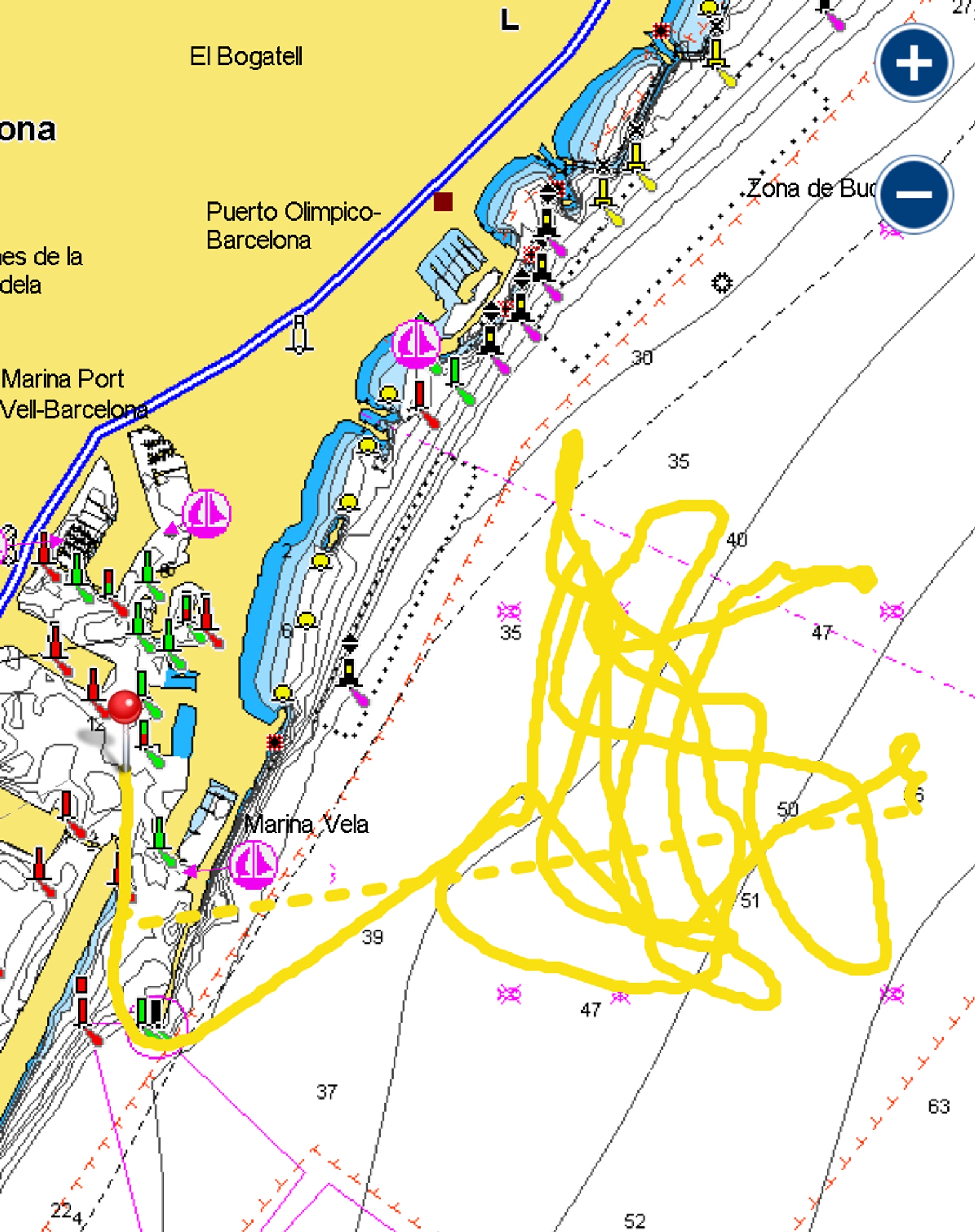
On-Water Recon Unit Notes – NYYC American Magic: Wavy two boat testing day with both boats on LEQ12 configuration. Today has been so far the roughest sea state American Magic has seen in Barcelona with wind chop of 1m, 4” @160º and 3 swells in the mix (1.7m, 5” @130º / 0.8m, 5.2” @100º / 1m, 6” @050º) that made life difficult for the crew.
Roll out was @8:45h for Magic and @10:03h for America both with the same foil configuration as yesterday, i.e. One Design foils on port and silver LEQ12 foils on starboard. Tom Slingsby was back on board after missing some days. Dock out was 11:26h and out of the port @12:02 where we had 7-9kt of patchy wind @160º. Magic rigged up MN-3 main and jib #2 sails while America had MN-2 with jib #2. Sailing began @12:08h upwind on starboard trying to get both boats lined-up but America struggled to take off while Magic was gracefully sailing around her waiting for her take off. They lined up eventually, but it was noticeably harder for America to take off when dropping off the foils, which happened regularly for both of them. Take off speed was @16kt boatspeed (BSP), and they sailed upwind on starboard tack @24kt BSP, 100º COG when in the pressure and 20kt BSP, 80º COG when in the lulls. They stopped @12:29 for a jib change to #1 probably looking for earlier and easier take offs.
After a quick debrief they resumed sailing @ 12:42h and after 15’ of straight-line starboard tack sailing (25kt BSP @110º COG) America from leeward had gained a considerable distance ahead of Magic, same height, which is interesting as this is the tack in which both boats sailed on the One Design foils, so whichever was the contributing factor, it should not be credited to the foils.
Again, it was noticeably harder for America to take off when, too often, dropping off the foils and Magic looked always more under control. The wind had picked up to 12-14kt and they went on a short port tack upwind (24kt BSP, 200º COG) to bear away and gybe into long a starboard downwind (35kt BSP, 360º COG) in which I couldn’t notice significant speed differences.
America stopped @13:45h while Magic sailed straight back into port to finish her day, apparently due to low batteries. America resumed her downwind sailing @13:58h on a port tack (35kt BSP, 300º COG) followed by a couple of short beats during which they seemed to be much more under control and having more fun than earlier in the day. They went back to port @14:35h to dock in @15:03h. Lea Sitjà.
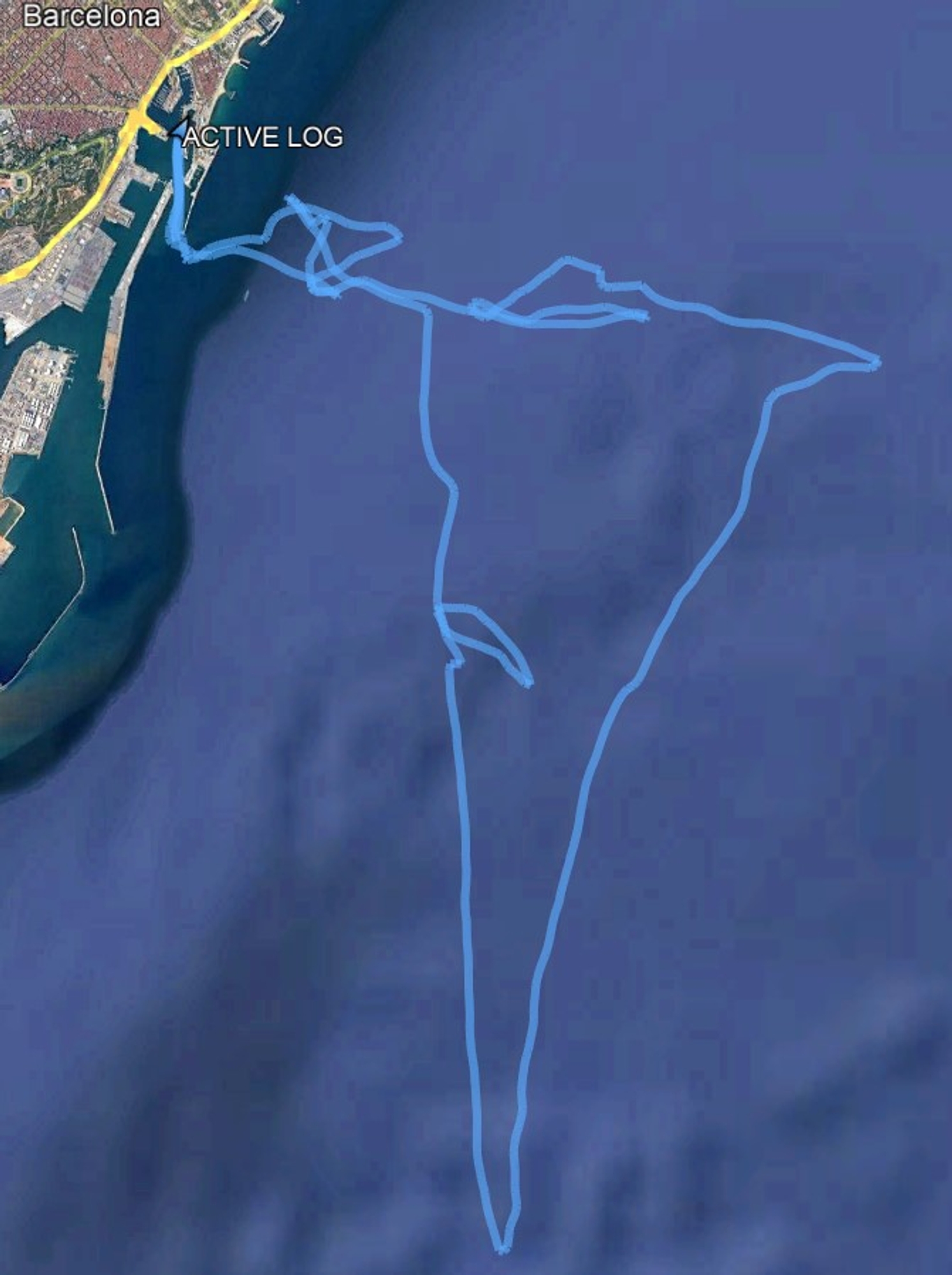
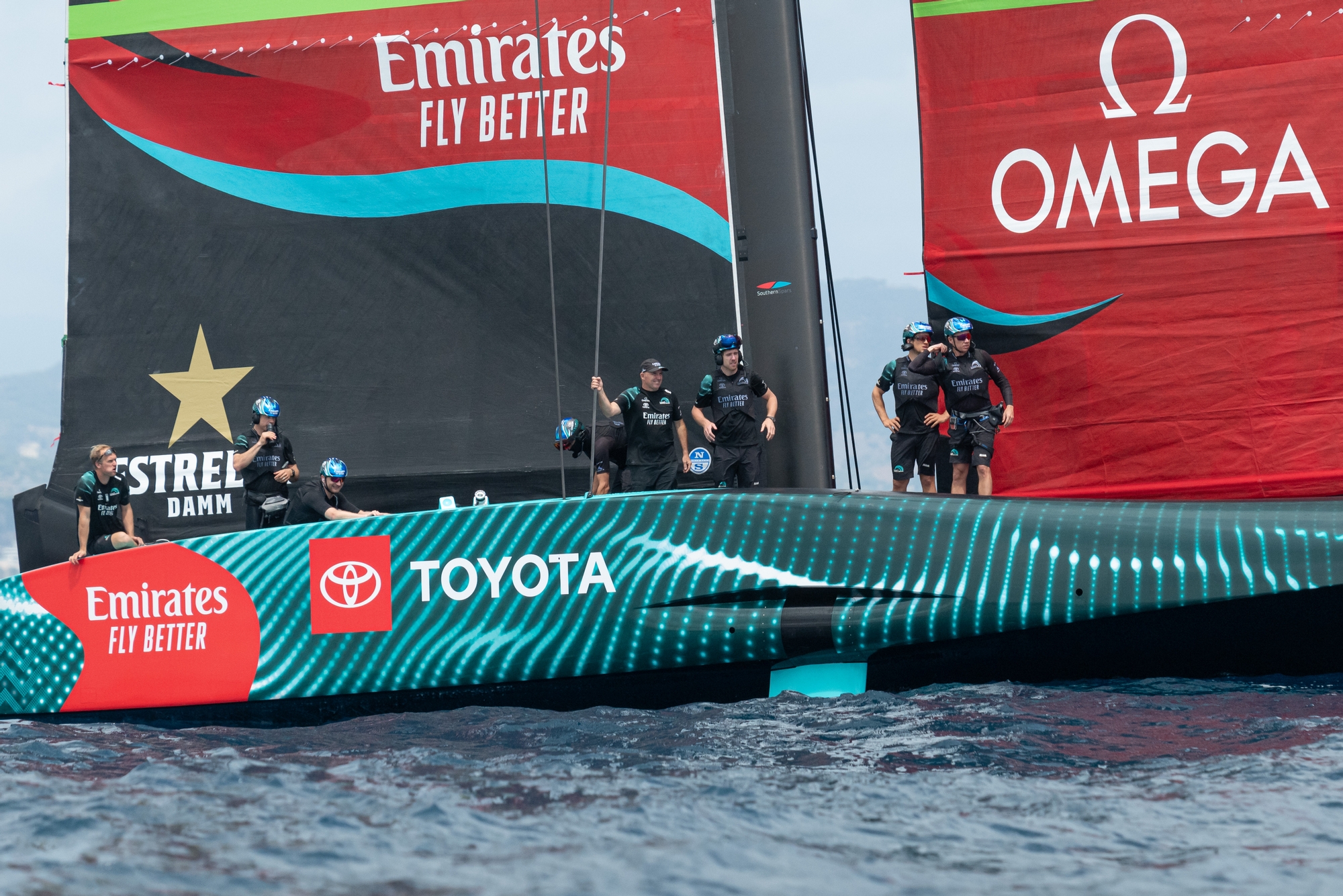
© JOB VERMEULEN
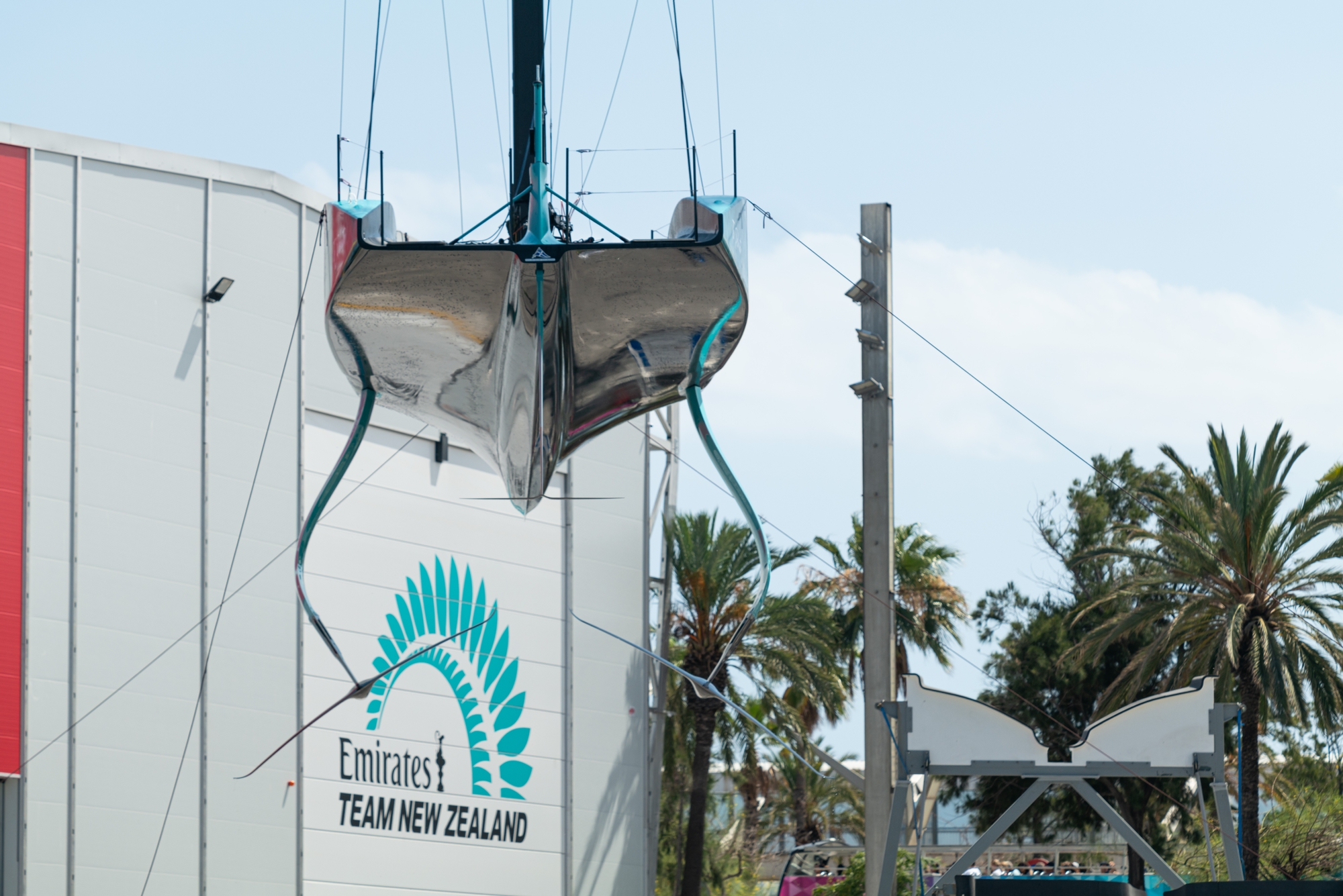
© JOB VERMEULEN
